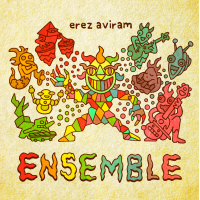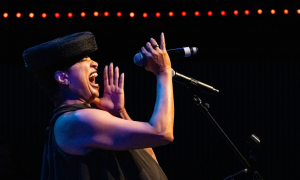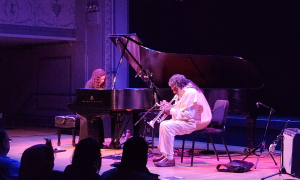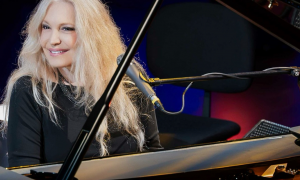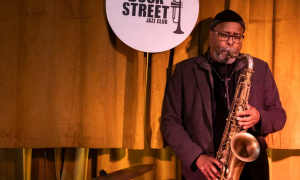Home » Jazz Articles » Live Review » Fare Thee Well: A Celebration of Fifty Years of the Grat...
Fare Thee Well: A Celebration of Fifty Years of the Grateful Dead, July 3,4 & 5, 2015
 Mickey Hart, Bill Kreutzmann, Phil Lesh, Bob Weir, Trey Anastasio, Bruce Hornsby, Jeff Chimenti
Mickey Hart, Bill Kreutzmann, Phil Lesh, Bob Weir, Trey Anastasio, Bruce Hornsby, Jeff Chimenti Fare Thee Well: A Celebration of Fifty Years of the Grateful Dead
Soldier Field
Chicago, IL
July 3, 4, 5, 2015
Fare Thee Well: A Celebration of Fifty Years of the Grateful Dead was one of those rare events that surprises and satisfies in equal measure. The temptation is to over-speak, then, is simply another aspect of the profundity of occasion, rooted in the conception and execution of the concert(s) themselves that created a groundswell of public discussion, most of which escaped the mainstream media til the initial shows in the iconic band's native California the last week of June,
But then, that's a fundamental aspect of the story of the Grateful Dead, a rock and roll band that transcended its role as a musical unit and in so doing helped create a self-sustaining unconventional community, that while it became unwieldy at times during their career, has become anything but a burden in the twenty years since the death of its titular leader, guitarist Jerry Garcia.
The shadow of the late cultural figure cast wide and long over Fare Thee Well, as it has over all Dead-related activities since his passing. But, based on the exemplary and often spectacular performances during the 4th of July weekend in Chicago, the so-called 'core four'-rhythm guitarist/vocalist Bob Weir, bassist/vocalist Phil Lesh and percussionists Bill Kreutzmann and Mickey Hart and their comrades-guitarist/vocalist Trey Anastasio, pianist/vocalist Bruce Hornsby and keyboardist/vocalist Jeff Chimenti-not only played up to the guitarist/vocalist/songwriter's standards, but exceeded many expectations, at least based on the somewhat erratic performances the previous weekend in Santa Clara California at Levi's Stadium.
And they did so often, and in such startling ways-who knew Phish guitarist Anastasio could play raw blues like he did to complement Weir's sparse slide work on "Little Red Rooster"?-that the performances would no doubt elicit a knowing smile from the titular leader of the band even though he was known to abhor the stadium shows. Certainly given the increasingly frequent (and usually shared) smiles lighting up the faces of the players all around the stage as the three concerts progressed at Soldier Field, the musicians would agree.
What the good ol' Grateful Dead did in with Fare Thee Well was show their generation of rockers (and those to come) how to fashion a dignified but no less joyful celebration of their shared history, equal parts knowing, though not nostalgic, recognition of their past, combined with a guarded but nevertheless optimistic eye to the future. As elegant as was the late Bill Graham's presentation for the Band's "Last Waltz," that concert turned too Hollywood with its parade of guests. and by definition, the adieu of Bob Dylan's former backing band really did not signify the end of an era as does Fare Thee Well. And Anastasio's presence, particularly as he was specifically selected by the core four, was symbolic of the passing of the proverbial torch to Phish as direct descendants of the Grateful Dead.
Forget the multiple ticketing snafus and the mercantile campaign that piled up as the dates drew close: such mercenary efforts are inevitable and, judging from the number of attendees at Soldier Field sporting one kind of item or another emblazoned with "Steal Your Face" or some variation thereof, the plethora of merchandise is but a reflection of the depth to which fans want to not just remember, but be reminded of this happening. Whatever might be questionable and/or suspicious about the production and presentation overseen by Peter Shapiro and Madison House, or the Rhino marketing operation to which the Dead have otherwise (rightly) trusted such endeavors, will slip away like the color fades in the t-shirts and baseball caps while the remembrance of the music remains vivid.
And music, after all, is the source of all this devoted concentration. The Chicago concerts lived up to, and quite probably exceeded, the expectations of the audience and perhaps the band itself, particularly after the miscues and various slip-ups occurring at the first pair of shows. Yet that in itself is accurate reflection of Grateful Dead history as they often did not rise to the occasion in question and so it was in their home state the last weekend of June; no doubt some intense wood-shedding took place during the ensuing week to devise setlists and arrangements that would accurately highlight the shared talent of the group the lineup of which quietly acknowledged on July 5th within lighting artiste Candace Brightman's imaginative lights and video displays: individual portraits as well as a group photo on the video monitors was the only introduction as the men gathered stage front (as they had at the outset of the night before the rousing start of "China Cat Sunflower.")
This was a complementary collective of talent boasting the best of both great eras of keyboardists—Bruce Hornsby carrying the torch from Keith Godchaux on grand piano while Jeff Chimenti fulfilled the role of unsung hero, largely on Hammond organ but occasionally on synthesizer, enacting the tradition of long deceased founding member Ron "PigPen" McKernan, but even more so the late lamented Brent Mydland who imparted so much inspiration to the group for over a decade spanning the late Seventies to the late Eighties.
And what's more accurate to state about guitarist/vocalist Trey Anastasio's assumption of this role was that its constitutes one of the most courageous acts of his life in and out of music? If any self-consciousness or nerves remained by the time he walked on stage at Soldier Field, it was quickly replaced by pleasure deriving from fulfilling his multiple roles with panache and pleasure. The knowing smile on his face was priceless as he sang "Bertha," but no more so than the borderline goofy grin that lit up his slightly craggy countenance as he slid into the instrumental groove of "Scarlet Begonias" and stepped lightly to the mike to sing, at this point, for all the world radiating a sense he felt deeply blessed to share the stage with some of his musical heroes. Yet whatever emotions ran deep through Anastasio's heart and those of his compatriots, the feelings only served to generate musicianship that did justice to the songs, their history and each other.
The titular leader of Phish's guitar solo on "Stella Blue" lit up lyricist Robert Hunter's great images even as it ached with the same sublime melancholy of Bob Weir's singing. And while this wasn't exactly the point where the much-maligned rhythm guitarist/vocalist began to redeem himself—it was possibly the denouement of "Me and My Uncle" that was lost with the dropout of satellite signal as the Vermont movie house showing the live stream, Palace 9 Cinema, but more probably the call and response guitar he and Anastasio were engaged in on "Tennessee Jed" when the transmission resumed about five minutes later. By the time these shows were through, there was no question that Fare Thee Well Chicago was the logical extension of the middleman extraordinaire position the youngest member of the Dead had so honorably-not to mention so graciously!-formulated for himself during those years Garcia floundered.
Some of the weekend's most memorable moments revolved around Weir. The transition out of the Fourth of July's "Rhythm Devils/Drums/Space" segment into "Lost Sailor," then "Saint of Circumstance," could not have been handled with more delicacy. The comforting sense of place thus conjured foreshadowed the generally subdued reflective nature of the final show which, if it seemed low-key or even anti-climactic at times, also carried its own inimitable sense of logic: by the time the band launched into "Know You Rider"" on Sunday evening, they had proven themselves.
Setlists rarely tell anything but the superficial about a concert and those of Fare The Well even less so. So many more turns of verbal phrase carried new and greater meaning for both the artists and their audience than even those from which the event took its name. But in delivering "Cassidy," Weir deliberately emphasized by repetition co-author John Barlow's refrain 'Fare thee well now/Let your life proceed by its own design/Nothing to tell now/Let the words be yours/I'm done with mine.' The cyclical references in the lyrics to "Truckin'" belied that finality, but no more so than the way the ensemble picked up speed as they jammed into the tune to begin the second Sunday: the perfectly loose swing of drummers Bill Kreutzmann and Mickey Hart were never more evident than here.
The inclusion of such chestnuts, and there were a fair share of them, might've been more predictable had there not been such astute juxtapositions with semi-obscure gems as Lesh's "Passenger" and the fully-formed outtake from Workingman's Dead (Warner Bros., 1970), "Mason's Children;" such inclusions no doubt served the dual purpose of keeping the ensemble sharp as well as casting aside 70,000 or so attendees' expectations and preconceptions, in order to more fully observe and appreciate the flow of the performances, the first two nights of which were equally brilliant, albeit mirror images of each other.
July 3rd began tight and concise, loosening up as set two progressed and perhaps a bit too much so had not the triumphant trilogy of "Help on the Way"/Slipknot"/"Franklin's Tower" punctuated the whole night with resounding authority. The group began slowly but surely the next night gathering momentum inexorably on "Liberty" as they moved on from "The Golden Road (To Unlimited Devotion)" to "Lost Sailor" comparison of the two distinct approaches serves no better purpose than to illustrate how expertly these musicians manage the dynamics of their playing and singing.
On the latter front, group vocals were increasingly tuneful and confident as the weekend progressed, but while the emotion of the event carried bassist Phil Lesh through the opening of his original "Box of Rain," he didn't acquit himself so endearingly on "Unbroken Chain," while the epic nature of "Terrapin Station" might well have been enhanced by multiple lead vocals including Hornsby, whose contributions on that front were somewhat limited though no less effective for it, throughout the weekend.
Given Grateful Dead history of applying short shrift to their singing (the gleeful serendipity they applied to improvising doesn't work with shared voices), that component of the sound was a most delightful surprise particularly in one instance, again deliberately imbued with significance, as the second encore of the final night; the harmonies might've been ever-so-slightly wobbly on the heartrending lyrics married to gorgeous melody on "Attics of My Life," but that only made the placement of the song that so effectively concludes American Beauty (Warner Bros.,1970) all the more touching and wholly appropriate to the proceedings.
And not just because the unctuous host of the post-show interviews mangled his attempt to link its verbal allusions. Roughly a half-hour prior, during a vulnerable delivery of "Days Between," Bob Weir captured a knowing sense of time and place within both the tune and the words of one of the very last songs long-time Dead lyricist Robert Hunter composed with long-collaborator Garcia, in so doing clarifying the ever-evolving sense of community within the Grateful Dead oeuvre. The latest gathering no doubt looked as mammoth as it felt in the Illinois city's football stadium where the band played their final show with the fallen leader.
On a live stream the likes of which took place at numerous venues around the country like South Burlington's Palace 9 Cinema, gargantuan fireworks at adjacent buildings, then launched from the upper perimeter of the edifice itself, seemed almost as real-life as the rest of the broadcast on Independence Day. In combination with its smooth melts and fades and creative camera angles, including eye-opening closeups, the deep and balanced audio mix made it seem far preferable to being in the same crowded 'room' as the band or enjoying a couch tour from the comforts of home.
The amenities offered by music-loving theater staff—selling sandwiches and baked goods all three night plus grilling outside during set-break Sunday only added to the relaxed summertime atmosphere. Attendees were encouraged to dance inside as well as to come and go out of the theater if they chose not to avail themselves of the intermission, a show in itself featuring music composed especially for Fare Thee Well by guitarist Neal Casal (Ryan Adams' Cardinals, Chris Robinson Brotherhood) played alongside (not really behind) vintage film footage collected by drummer Bill Kreutzmann's film-making son Justin.
Based on via record sales reports from pay-per-view YouTube purchase et. al., the entrepreneurs behind Fare The Well apparently achieved their stated goal at the outset, that is to make the occasion as readily and widely available as possible to the public. The demographics ran the gamut at the venue while the local audience had a more limited following, most stoners and/or aging hippies, sprinkled with kids accompanied by parents and, on opening night, a silver-haired couple who came (and left after the first set) curious to see what had so fascinated their fifty-plus year-old son in the hope that they might bond more closely.
Which, of course, would not have been so readily apparent had not, all operation excellence aside, had not these seven musicians, largely casting their egos aside, so vigorously and empathetically displayed the style and skill they've accumulated during the course of their careers. Like the Grateful Dead at their best, this ever-so-unique septet created a space in which an all-enveloping moment of truth blossomed that will no doubt change the lives of more than a few who took part in it, near or far.
Tags
About Grateful Dead
Instrument: Band / ensemble / orchestra
PREVIOUS / NEXT
Support All About Jazz
 All About Jazz has been a pillar of jazz since 1995, championing it as an art form and, more importantly, supporting the musicians who make it. Our enduring commitment has made "AAJ" one of the most culturally important websites of its kind, read by hundreds of thousands of fans, musicians and industry figures every month.
All About Jazz has been a pillar of jazz since 1995, championing it as an art form and, more importantly, supporting the musicians who make it. Our enduring commitment has made "AAJ" one of the most culturally important websites of its kind, read by hundreds of thousands of fans, musicians and industry figures every month.














